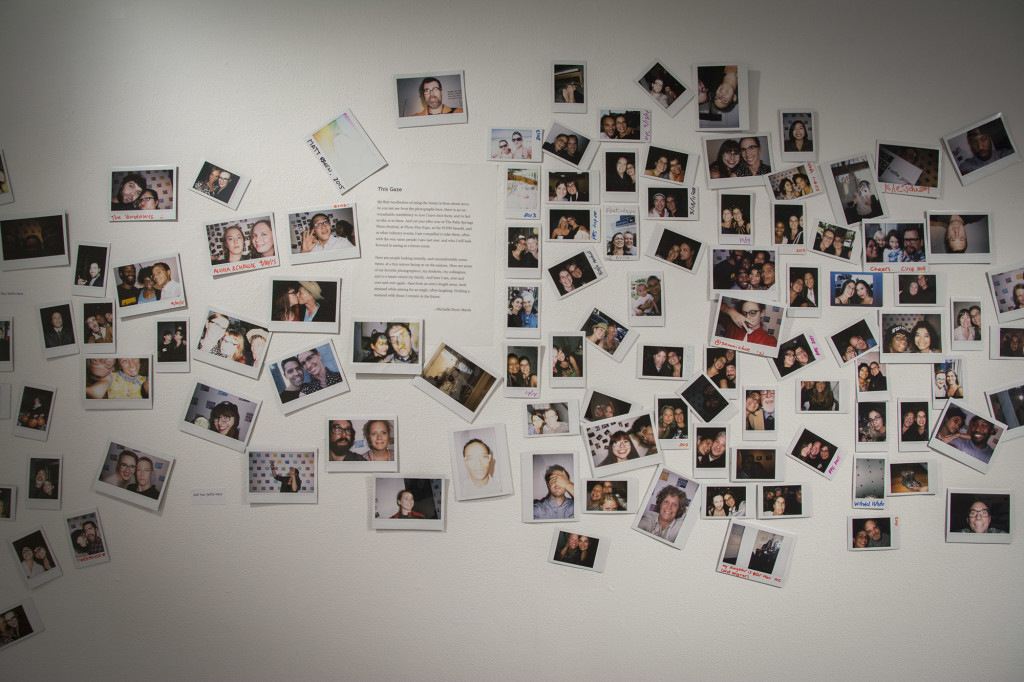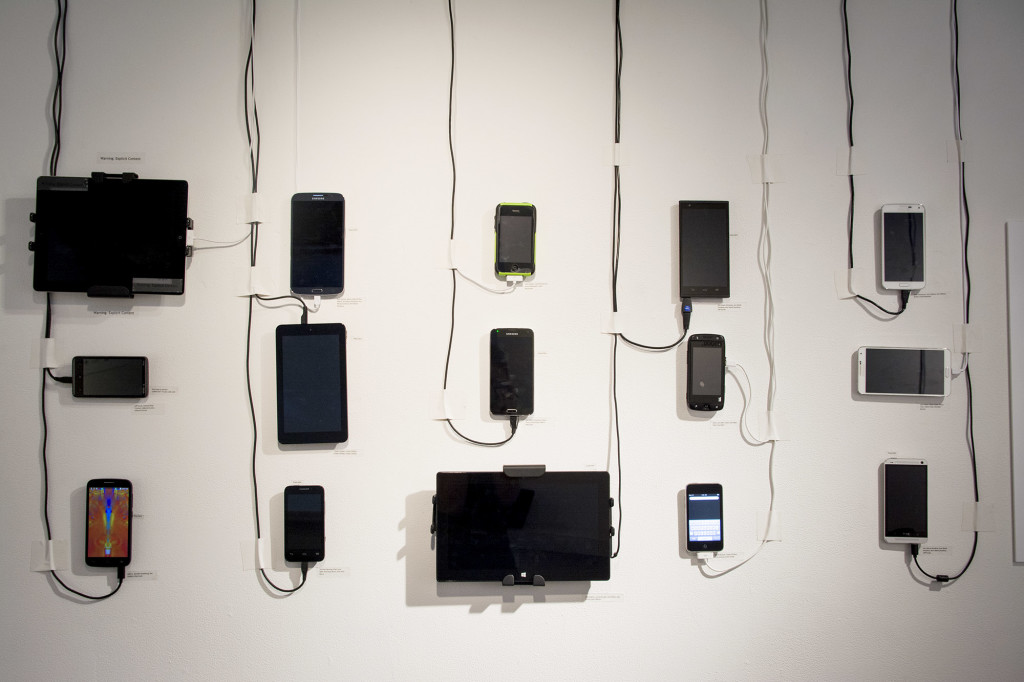You might be surprised to learn that the word “selfie” is officially in the Oxford English Dictionary and has been for some time. It is defined as, “A photograph that one has taken of oneself, typically one taken with a smartphone or webcam and shared via social media.” What you may not know is that there is a serious discussion going on in the art community regarding the definition of “selfie” culture. The Photographic Center Northwest is now joining that discussion with an exhibit, titled “Me and My Selfie.”

The Me and My Selfie exhibition is still on the walls at the Photographic Center Northwest. The walls are covered with interactive electronics and visuals.
The exhibit does not feel big in terms of space, given that it only occupies the lobby area of the Center. The gallery’s petite size is because its medium is digital. That is, the work on display is only viewable via various electronic devices comprised mainly of cell phones and tablets placed around the room. Susan Hood, the Marketing Manager, guided me through the exhibit. She felt that the exhibit’s opening is timely, given that there is so much focus on selfies with apps like Snapchat, she felt compeleld to ask, “Why are selfies so huge?”
This is no traditional art exhibit—it is all interactive. The “photos” have no frames—unless you count a screen as one. You can spend your time swiping through an iPhone or an Android, experiencing some artistic representations of selfies which are breathtaking and engaging, or you can take a look at something you’re more likely to take yourself—just random documentations taken by some of the museum staff. Photographers like Jennifer Greenburg and Jonathan David Smyth stand out in innovating, provocative photos that skew the lines between art and selfie.
Sarah McLaughlin, a Seattle University alum who graduated with a degree in photography, sees selfies as an extension of self-portraits.
“I think that photographing ourselves and seeing ourselves in that way really resonates with some part of human nature and I think selfies are a part of that too,” McLaughlin said, “It’s the response to that same desire but with tools that everyone has access to [that] creates selfie culture. It’s a really interesting way of documenting ourselves and our experiences.”
The center does an excellent job of making the exhibit interactive. At the end of the gallery, there is a chance for gallery goers to take a selfie of their own—the exhibit is even equipped with a selfie-stick to assist. But what’s more, the public can Tweet or Instagram photos with the hashtag, “#selfie_pcnw” and be instantaneously added to the photos in the gallery.
Words like “Shoefie” (a photo of your current footwear), and “Thirstbait” (The act of intentionally creating an attractive looking photo to impress someone you’re into) also appear in the gallery, showing just how far selfies—and their spin-offs—have come. These words, and the many modes of selfie-taking (i.e. a selfie-stick, a polaroid, or otherwise) convolute the real definition of what a selfie is. The exhibit, however, clears up this confusion with its own definition: “A selfie is a photographic image of and by a person from an arm’s length or using a mirror, often taken on a device that is not exclusively a camera and shared through text, email or social media.”
Chieko Phillips, the Public Programs Curator at the Photographic Center and one of the leads behind the exhibit, selected 268 selfies to be displayed, found devices and tablets for viewing and helped get the whole show off the ground.
According to Phillips, the exhibit team originally considered a show of self-portraiture, a more traditional photography exhibition, but looked instead at more contemporary material.
“Eventually, [we] landed straight on selfies, which are the extreme contemporary kind of end of the spectrum of self representation through photography, so that was the sort of ‘ah-ha’ moment,” Phillips said. “They’re undeniably significant and our mission is to facilitate creation and conservation of significant photography, so we cannot deny that they are significant.”
Phillips also said that selfies are a, “vernacular photography,” meaning that anyone and everyone can do it once they have access to a device. The Center is, “Exploring the selfie as its own type of photography, not trying to connect it to self-portraiture” she said. It is not, “Trying to create a grand message about what selfies do and do not mean.”
Me and My Selfie ends on Oct. 31 and is located on 12th Ave next to The Chieftain. The only question you’ll have left to wonder is—where will selfies go next? My money is on selfie-taking drones.
Scott may be reached at sjohnson@su-spectator.com









